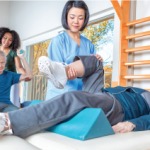Ms. Black advises rheumatologists to refer to OT if there’s a new JIA diagnosis and a child has joint symptoms that are or may get in the way of function. That way, the therapist can evaluate and decide if ongoing therapy is needed. An evaluation is important even in young children who are trying to meet developmental milestones.
Ms. Black shares the example of a 12- to 18-month-old child with a swollen knee learning to walk. She says, “It would be even more important for [this patient] to be referred to therapy so that they can work on that knee and walk at the right time.”
For adults, a referral to PT and OT should occur as soon as they receive a diagnosis of rheumatic disease, says Dr. Steinbarger. She acknowledges that approach may be “pie in the sky.”
“Even if at that point, [the patient is] not having a specific hot joint or anything like that, there are a lot of things they need education on,” she says. These things may include figuring out the appropriate physical activity when they have a flare.
For PT and OT, specialists will evaluate and discuss goals with patients related to physical activity. Often, reaching those goals involves adapting and remediating treatment plans as needed.
Baby Steps
In adults, Dr. Steinbarger says current federal guidelines—30 minutes of activity, five days a week, along with strengthening exercises—can feel overwhelming to someone with rheumatic disease.
Dr. Steinbarger tries to be as specific as possible to get patients with rheumatic diseases started with physical activity to avoid feeling overwhelmed. Often, achieving this starts with baby steps: discuss specifics, focus on physical activity over such messages as “You must go to the gym” and acknowledge that fatigue is a real factor.
Often, she recommends aerobic exercises, such as walking, swimming, housework or gardening as a starting point. She emphasizes the importance of movement to help stave off an increased risk for cardiac problems.
If a patient has osteoarthritis or other joint limitations, Dr. Steinbarger focuses on lower-impact activities, including biking, swimming and walking.
These recommendations also involve making patients aware of what they’re already doing. Dr. Steinbarger had a patient who quilts and claimed she didn’t exercise much. Through more conversation, the patient revealed that she used a large quilting machine in her garage that she often walks around.


